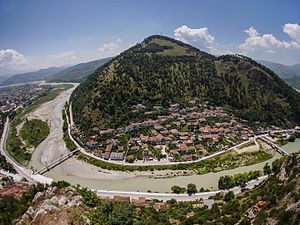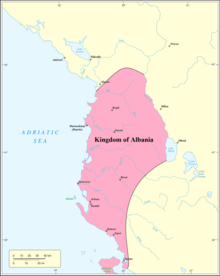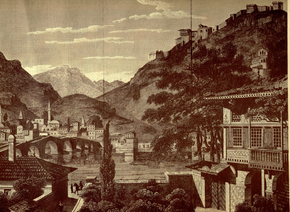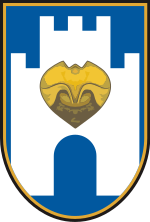Advises
|
Berat Berati |
||

|
||
|
Coordinates: 40 ° 42 ′ N , 19 ° 57 ′ E |
||
| Basic data | ||
|---|---|---|
| Qark : | Advises | |
| Municipality : | Advises | |
| Height : | 60 m above sea level A. | |
| Residents : | 36,496 (2011) | |
| Telephone code : | (+355) 032 | |
| Postal code : | 5001-5006 | |
| Politics and administration (as of 2019 ) | ||
| Mayor : | Ervin Demo ( PS ) | |
| Website : | ||
| Culture and history | ||
| City foundation : | 314 BC Chr. | |
| City Festival : | 13.september | |
 View of the old town part Gorica (2016) |
||
Berat ( Albanian also Berati ) is a city in Albania . It lies on the Osum River and, according to its own information, had 64,473 inhabitants in 2004, but only 36,496 inhabitants according to the 2011 census. The entire large community ( bashkia ) , which was expanded in 2014 , has 60,031 inhabitants (2011).
The city of a thousand windows , which was officially designated a museum city in 1961 and a UNESCO World Heritage Site in 2008 , is under special protection: new buildings are prohibited in three parts of the city with the typical historic white houses . Especially thanks to these three compact old town quarters Mangalem , Gorica and Kalaja (German: Burg) and the many mosques and churches, Berat is one of the most important sights in the country.
Berat is the capital of the Qark of the same name and the seat of an Orthodox bishop .
etymology
The first written mention of the city, in Greek Poulcheriopólis Πουλχεριοπόλις , comes from the 9th century and means "beautiful city". In 1019 the Slavic name Belagradon appears, which is the translation of the older name and means "white city". Belgrade is mentioned in 1230 and 1258 . Other names are Bellagradi (1280), Beligrad (1345) and Belgradi (1431).
Location and neighborhoods
The old Bashkia Berat covers an area of only 6.3 square kilometers. The surrounding communities of Otllak , Roshnik , Sinja and Velabisht have also been part of Berat since 2015 . The Tomorr mountain range ( 2416 m above sea level ) rises to the east .
The city was originally built as a fortress on the rocky hill 187 meters above sea level. A. where the river Osum penetrates through a narrow valley into the central Albanian plain of Myzeqe . The castle towers over this strategic point, which not only consists of the fortified structures, but also encompasses an entire district with numerous churches and mosques. The historic Gorica district is on the opposite bank . The Mangalem district and today's city center extend below the castle . In the north in front of the city new quarters with numerous prefabricated buildings were built during the communist era.
history
Early history
Prehistoric dwellings could be found around 2600 BC. Be proven. The castle hill was built in the 4th century BC. First fortified by Illyrians . The place was the settlement center of the Illyrian Dassaretes . At the end of the 4th century BC, they became dependent on the Kingdom of Macedonia . Presumably it was Kassander who re-established the old town as a city and settled Greek colonists. In honor of his father, he named the city Antipatreia . The city also flourished under the rule of the Romans .
middle Ages
The Bulgarians occupied the region in the 9th to 11th centuries . At that time, Berat was an Orthodox bishopric. The eparchy was under the Metropolitan of the Archdiocese of Ohrid . Two early Christian relics are the two manuscripts Codex Beratinus 1 and Codex Beratinus 2 , which are over 1000 years old, but are now kept in Tirana .
In 1018 the Byzantines took back the city. As a result, Berat came under changing rule of local despots, the kings of Naples (1273), the Bulgarians and the Serbs .
On February 21, 1272 Charles I of Anjou proclaimed the Regnum Albaniae - Kingdom of Albania, whose territory roughly corresponded to a triangle between Dyrrhachion , Valona , Kanina , Buthroton and Corfu . Gazo Chinard , royal vicar general of the Kingdom of Albania since 1272 and captain general of the Neapolitan army, was sent against Berat. Sufficient troops ( Saracens from Nocera ), provisions and money were supplied to him so that he could subjugate the whole country as quickly as possible . For greater security, he should have the Albanians hold him hostage. Everything went according to plan and the Albanians proved their loyalty by voluntarily holding hostages. Berat surrendered in 1273. The prisoners, mostly Greeks, were sent to Trani in Apulia in April 1273 and received a monthly pension for their maintenance. The campaign of 1272/73 was only to be the first in a series.
When the Byzantine Emperor Michael VIII Palaiologos sent an army against Dyrrhachion from Ioannina in 1274 , he recaptured Berat and stationed a strong garrison in Butrint. Quite a few of those who had pledged allegiance to the Anjou joined the Byzantine emperor. So does Gjon Muzaka .
In spring 1281 , the Byzantine Emperor Michael VIII defeated the army of Charles I of Anjou under the command of the Burgundian knight Hugo le Rousseau de Sully in a coalition with local Albanian forces and stopped the further expansion of the Anjou east of the Adriatic. On this occasion Andrea I. Muzaka was able to establish a largely independent territorial rule and expand his area to include Tormoniza near the mountain Tomorr , Berat, Këlcyra and Skrapar .
After the death of his father Theodor I Muzaka (around 1335), Andrea II. Muzaka took over the rule and made the heavily fortified Berat the capital of his principality Muzakaj .
In autumn 1345, Berat and Valona fell to the Serbs by the Serbian army leader Kersak . Berat was renamed Beligrad ( White City ). From 1346 the Serbian tsar Stefan Uroš IV. Dušan installed his brother-in-law Johannes Komnenos Asen as governor of Valona, Kanina and Berat.
After the disintegration of the Serbian Empire in 1355 Berat was under the rule of its former governor, John Komnenos Asen (1345 to 1363), the to 1363 of 1355 there de facto be Principality of Valona instituted; it was followed by Alexander Komneno Asen (1363–1372) and Balša II (1372–1385).
In the battle of Savra in the Myzeqe on the Vjosa on September 18, 1385, which was the first direct participation of the Ottoman troops in Albania, Karl Thopia retained the upper hand with Ottoman help; Balša II died in the process. His widow Comita Muzaka (sister of Theodor II. Muzaka ) was only able to maintain control over Vlora , Kanina , Himara and Berat in the south, while the Zeta and the region around Skadar fell to Đurađ II. Balšić , who had escaped from captivity . Comita Muzaka ruled from Berat until her death in 1396. At that time, the Muzaka family regained control of Berat. In 1417 the area was conquered by the Ottomans . In the 1420s, the aristocratic Muzaka family (now Ottoman vassals ) ruled Berat.
Theodor III. Muzaka , a colleague of Skanderbeg in the League of Lezha , bequeathed his territory to Skanderbeg before his death. The city was finally lost due to a surprise attack by the Ottomans, because the siege of Berat initiated by Skanderbeg in 1455 was unsuccessful.
Under the Ottoman rule, Berat was the seat of the Sanjak - Beys Yakup Bey Muzaka (son of Theodor III. Muzaka ) and a regional trading center. Both the Muslims and the Orthodox Church had important schools in the city.
Early modern age
In November 1670, the Ottoman writer Evliya Çelebi visited the city of Berat, among other places. At that time it was the seat of the Bey of the Sanjak Vlora and owned 489 feudal estates ( Turkish Tımar ). In addition to 5000 stone houses covered with red tiles, he counted 100 magnificent mansions with cisterns and fountains. Berat was divided into 30 quarters, and Çelebi describes the fortress and citadel of the city in considerable detail.
Modern times
In 1809 the Ottoman pasha of Albanian descent, Tepedelenli Ali , was able to annex the city to his rule for a short time. He installed his son Myftar as local governor. In 1822, the Ottoman sultan , Mahmud II , took Berat back after Ali Pasha was assassinated.
In 1851 Berat was shaken by a strong earthquake . The buildings erected shortly afterwards still shape the appearance of the historic districts today.
In 1903 there was a popular uprising in the city. The residents demanded a lowering of the excessive taxes and the occupation of the city offices with Albanians instead of Ottomans.
After the partisans drove the German troops out of the city on September 13, 1944 , a “ Democratic Government ” was formed in Berat in October with Enver Hoxha as Prime Minister.
Attractions
| Historical centers of Berat and Gjirokastra | |
|---|---|
|
UNESCO world heritage |
|

|
|
| "The city of a thousand windows" - Mangalem district , above the castle |
|
| National territory: |
|
| Type: | Culture |
| Criteria : | (iii) (iv) |
| Reference No .: | 569 |
| UNESCO region : | Europe and North America |
| History of enrollment | |
| Enrollment: | 2005 (session 29) |
| Extension: | 2008 |
The advisor cityscape is shaped by the Ottoman architecture , as you can find it comparable for example in Gjirokastra and Ohrid . Many cultural assets such as the Lead Mosque or Hysen Pasha Mosque have been renovated in recent years.
In 2008 the old town of Berat was added to the UNESCO list of world cultural heritage . There it is now used together with Gjirokastra as an example of the preservation of an Ottoman city and the coexistence of different cultures. According to an April 2013 report by the International Council on Monuments and Sites , the world heritage of Berat and that of Gjirokastra are in danger. The biggest problem would be the many illegal buildings near the historic city centers, especially in Gjirokastra. Another deficiency would be insufficient monitoring of developments on site. In addition, some important changes in the legislation would have to be made. The two sites threatened to be put on the Red List of World Heritage in Danger.
Mangalem
This district stretches up the hill to the castle. The houses are very close together, the facades facing the valley all have large windows. The city owes its name “City of a Thousand Windows” to this quarter. In formerly inhabited only by Muslims Quartier standing Bachelors' Mosque , the Lead Mosque and the King Mosque and the Halveti Teqe and the Ethnographic Museum, which allows an insight into the lifestyle of the Turkish time. Almost at the steepest point of the castle hill is the small Michaelis church above the river. The Rüfai-Tekke is also located in this district .
Gorica
For a long time this quarter was only connected to the rest of the city by a bridge, which is why little has changed here. The St. Spyridon Monastery from 1864 is particularly worth seeing. The Ottoman stone bridge called Ura e Goricës was built in 1780 under a certain Ahmed Kurt Pascha ; at that time it replaced an older wooden bridge. In 1922 it was renewed by the city administration.
Kalaja
The fortress of Berat, called Kala / -ja , is one of the most visited and most important sights of Berat. It is also the symbol of the city and is depicted on the city arms. The castle district still consists of numerous small houses, most of which are made of stone. Various churches with lavishly decorated icons can still be visited in the winding streets . These include the Church of the Holy Trinity ( Shën Triadha ) and the Church of Saint Mary of Blachernae . The ruins of the Red Mosque , the White Mosque and a Turkish barracks can also be found on the castle hill. The Roman cistern , which was in use until the 19th century, is worth seeing . Famous is the Onufri Museum, which shows works by the most important Albanian icon painter of the same name.
economy
After the collapse of communism , most of the factories in Berat were shut down. The city can therefore hardly offer any economic prospects. As a regional service and trade center, the place is in competition with numerous other cities of similar size in Central Albania.
In the tourism sector and hospitality industry some residents earn a living. Berat offers several hotels and restaurants for tourists. Several approaches have been taken to promote tourism , including with German help. Berat was one of the first Albanian places to set up a website for tourists and to set up clearly visible signposts .
In the countryside of Berat in recent years, several began farmers , vine growing and wine to produce .
politics
The lawyer Petrit Sinaj ( LSI ) has been the mayor of Bashkia since 2015 . The 31 members of the municipal council represent the city of Berat and 50 other surrounding villages. The center of the municipal coat of arms is a symbol of the advisors of the Muzaka noble family ; this is surrounded by the castle, which is completed below by an arch of the Ura e Goricës , under which the Osum flows.
Town twinning
Berat lists the following three partner cities :
| city | country | since |
|---|---|---|
| Fermo |
|
2010 |
|
Kruševo |
|
2010 |
|
Lovech |
|
2008 |
Sports
The Tomori Stadium is the third largest stadium in Albania. The local football club FK Tomori Berat will play in the second division in the 2013/14 season .
Personalities
- Angelina Srpska (* around 1440), saint of the Serbian Orthodox Church
- Onufri and his son Nikolla (16th century) worked as artists in the city for several years
- Babë Dud Karbunara (1842–1917), politician and founding father of Albania
- Sotir Kolea (1872–1945), politician
- Dhimitër Tutulani (1875–1937), politician and founding father of Albania
- Sami Bey Vrioni (1876–1947), politician and founding father of Albania
- Iliaz Vrioni (1882–1932), politician, founding father and three-time Prime Minister of Albania
- Sejfulla "Cekja" Myftari (* 1942), humorist and actor
- Alkan Nallbani (* 1971), artist
- Eni Koçi (* 1996), singer
literature
- Apollon Baçe, Aleksandër Meksi, Emin Riza: Berat, son histoire et son architecture . In: Editions Encyclopediques . Tirana 1996.
- Carl Patsch: The Sanjak Berat in Albania . In: Imperial Academy of Sciences Vienna (ed.): Writings of the Balkan Commission . Antiquarian department 3. Hölder / Repr. Kraus, Vienna / Nendeln 1976 (first edition: 1904).
Web links
- Bashkia Berat website (Albanian, English)
- Entry on the UNESCO World Heritage Center website ( English and French ).
- BeratExperience.com (tourism information , English)
Individual evidence
- ↑ a b Ines Nurja: Censusi i popullsisë dhe banesave / Population and Housing Census - Berat 2011 . Results Kryesore / Main Results. Ed .: INSTAT . Pjesa / Part 1. Adel Print, Tirana 2013 ( instat.gov.al [PDF; accessed April 14, 2019]).
- ^ Nomination file. (PDF) In: UNESCO. July 13, 2005, p. 44 , accessed December 2, 2015 (English).
- ^ A b Marika McAdam: Balcani Occidentali . Lonely Planet, S. 100 (Italian, online version in Google Book Search).
- ↑ Berat: Geography, History, Architecture values, Tourism, Craft ( Memento from January 18, 2013 in the web archive archive.today )
- ↑ Gustav Friedrich Hertzberg : History of Greece: since the death of ancient life to the present . tape 2 . Friedrich Andreas Perthes, Gotha 1877, p. 167 ( online version in Google Book Search).
- ^ Robert Elsie: A Biographical Dictionary of Albanian History . IB Tauris, London, New York 2012, ISBN 978-1-78076-431-3 , pp. 81 f . (English, online preview in Google Book Search).
- ↑ a b General Encyclopedia of Sciences and Arts . First Section AG. Hermann Brockhaus, Leipzig 1867, p. 299 ( full text in Google Book Search).
- ^ Arturo Galanti: L'Albania: notizie geografiche, ethnografiche e storiche . Societa editrice Dante Alighieri, Rome 1901, p. 118 (Italian, archive.org ).
- ^ Jean Dunbabin: Charles I of Anjou: Power, Kingship and State-Making in Thirteenth-Century Europe . Routledge, London / New York 1998, ISBN 978-0-582-25370-4 , pp. 91 (English, online preview in Google Book Search).
- ↑ General Encyclopedia of Sciences and Arts . First Section AG. Hermann Brockhaus, Leipzig 1867, p. 300 ( full text in Google Book Search).
- ^ Mark C. Bartusis: The Late Byzantine Army: Arms and Society, 1204-1453 . University Press, Pennsylvania 1992 (English, preview in Google Book Search).
- ↑ Muzakajt ne Myzeqe. Retrieved March 4, 2018 (sqs).
- ^ Carl Hermann Friedrich Johann Hopf : Chroniques gréco-romanes inédites ou peu connues . Weidmann, Berlin 1873, p. 282 (Italian, archive.org ).
- ^ Konstantin Jireček : History of the Serbs . tape 1 . FA Perthes, Gotha 1911, p. 385 ( archive.org ).
- ^ William Miller: Essays on the Latin Orient . University Press, Cambridge 1921, pp. 434 (English, preview in Google Book Search).
- ↑ History of the Serbs, p. 395
- ^ Donald Edgar Pitcher: An Historical Geography of the Ottoman Empire: From Earliest Times to the End of the Sixteenth Century . J. Brill, Leiden 1972, p. 45 (English, preview in Google Book Search).
- ^ A Biographical Dictionary of Albanian History, p. 27
- ^ John Van Antwerp Fine: The Late Medieval Balkans: A Critical Survey from the Late Twelfth Century to the Ottoman Conquest . University of Michigan, Ann Arbor MI, 1994, ISBN 0-472-08260-4 , pp. 391 ( preview in Google Book search).
- ↑ Miranda Vickers: Shqiptarët - Një histori modern . Bota Shqiptare, 2008, ISBN 978-99956-11-68-2 , Mbërritja e osmanëve, p. 19 (English: The Albanians - A Modern History . Translated by Xhevdet Shehu).
- ^ Edwin E. Jacques: The Albanians. An ethnic history from prehistoric times to the present . Ed .: MacFarland. Jefferson, 1995, ISBN 0-89950-932-0 , pp. 174 .
- ^ Abdul B. Sula: Albania's Struggle for Independence . New York 1967, p. 23 (English).
- ^ Robert Elsie : 1670 Evliya Chelebi: Seyahatname - a Journey to Berat and Elbasan. Retrieved April 25, 2018 .
- ↑ Miranda Vickers: Shqiptarët - Një histori modern . Bota Shqiptare, 2008, ISBN 978-99956-11-68-2 , 1.3 Pashallëqet e Mëdha të Shkodrës dhe Janinës , p. 43 (English: The Albanians - A Modern History . Translated by Xhevdet Shehu).
- ↑ Miranda Vickers: Shqiptarët - Një histori modern . Bota Shqiptare, 2008, ISBN 978-99956-11-68-2 , 2.6 Dobësimi i vazhdueshëm i pushtetit të Portës , p. 82 (English: The Albanians - A Modern History . Translated by Xhevdet Shehu).
- ↑ a b Berat në package (profile of Berat). Official website of the Bashkia von Berat, accessed on February 9, 2016 (Albanian).
- ↑ Icomos: Trashëgimia në rrezik (Icomos: Heritage in Danger). Top Channel , April 17, 2013, accessed April 19, 2013 (Albanian).
- ↑ CV e kryetarit (curriculum vitae of the mayor). Official website of the Bashkia von Berat, accessed on February 9, 2016 (Albanian).
- ↑ Bashkia Berat, qytetet dhe fshatrat sipas ndarjes së re administrativo-territorial (Bashkia of Berat, the towns and villages under the new administrative structure). (PDF) National Archive of Albanian Municipal Council Resolutions, 2015, accessed on February 9, 2016 (Albanian, PDF file; 66 kB).
- ↑ Partneritetet dhe binjakezimet e huaja te Bashkise Berat (2007–2011) PER NJE BERAT EUROPIAN ǀ Bashkia Berat. Retrieved October 22, 2017 .






